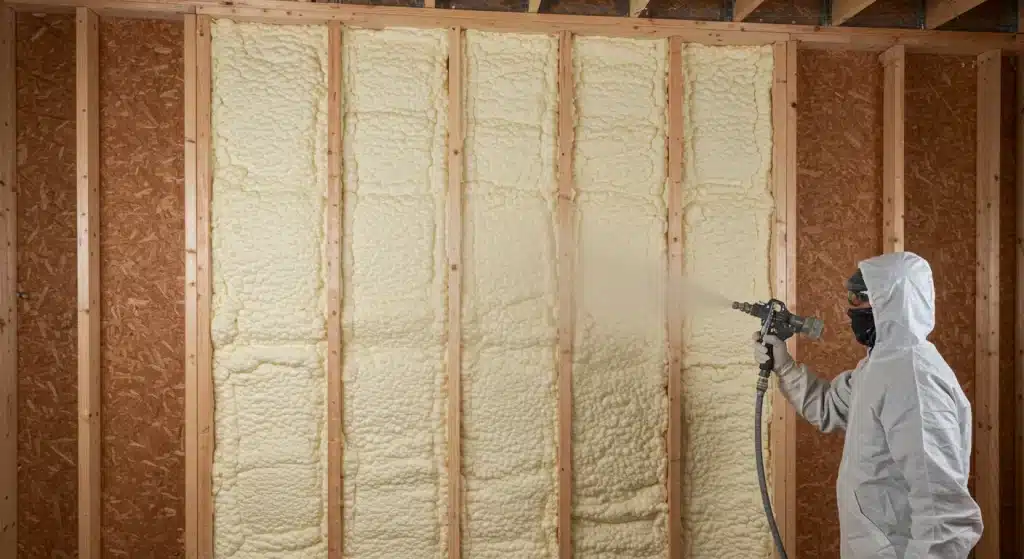Many homeowners in Newnan, GA make costly mistakes during insulation upgrades that lead to energy loss, moisture problems, and inefficient indoor comfort control. The most common errors include choosing the wrong type of insulation for Georgia’s humid subtropical climate, ignoring air sealing, and failing to remove old or contaminated insulation before new materials are added.
This article outlines common pitfalls and offers practical guidance backed by field experience and performance data. All recommendations are based on proven installation techniques and regional performance feedback to help homeowners make informed decisions.
Makeover Insulation has installed and removed insulation in thousands of Georgia homes, providing insight into what works and what doesn’t in this climate zone.
Skipping Air Sealing Before Adding New Insulation
Adding insulation without sealing leaks leads to minimal gains. Gaps around pipes, ducts, and attic penetrations allow conditioned air to escape, reducing efficiency.
Bonus Tip: Use a blower door test to detect leaks before any insulation is installed.
Common Leak Points
- Attic hatches
- Chimney framing
- Recessed lighting fixtures
- Plumbing and wiring penetrations
Using the Wrong Type of Insulation for Georgia’s Climate
Material choice affects energy performance, moisture resistance, and lifespan. Georgia’s high humidity makes material selection critical. Fiberglass works well in vented attics but performs poorly in unvented or moist areas. Spray foam resists moisture but must be installed correctly to avoid trapping humidity.
Comparison of Insulation Types
| Insulation Type | Best Use Areas | Moisture Resistance | R-Value per Inch | Air Sealing Ability |
|---|---|---|---|---|
| Fiberglass Batts | Walls, attics (vented) | Low | 3.1 – 3.4 | Low |
| Cellulose (Blown-In) | Attics, walls | Moderate | 3.2 – 3.8 | Moderate |
| Spray Foam (Closed) | Attics, crawl spaces | High | 6.0 – 7.0 | High |
| Spray Foam (Open) | Walls, unvented attics | Moderate | 3.5 – 4.0 | High |
Ignoring Insulation Removal When Upgrading
Layering new insulation over old, damaged material reduces effectiveness. Mold, rodent activity, and compacted insulation all reduce R-value. Removal is often necessary to avoid health risks and to install modern materials properly.
Bonus Tip: Schedule removal during low humidity periods to reduce mold risk and speed cleanup.
Relying on R-Value Alone
R-value measures thermal resistance but doesn’t reflect real-world performance. Installation quality, air sealing, and moisture control affect actual results.
Technical Data for Common Materials
| Material Type | Nominal R-Value/in | Vapor Retarder Required? | Settling Risk Over Time | Combustibility Rating |
|---|---|---|---|---|
| Fiberglass Batts | 3.2 | Yes (in humid areas) | Low | Class A |
| Cellulose (Blown-In) | 3.7 | Often | Moderate | Class 1 (Treated) |
| Closed Cell Foam | 6.5 | No | None | Class A |
Overlooking Ventilation in Sealed Spaces
Sealing an attic or crawl space with spray foam without adding controlled ventilation causes moisture buildup, mold, and eventual structural damage.
Market Insight: According to the U.S. Department of Energy, 90% of U.S. homes are under-insulated, and poor ventilation is one of the top contributors to moisture-related issues .

Things to Consider Before Making a Decision
- Current insulation condition: Wet or pest-damaged insulation must be removed.
- Humidity levels: Choose moisture-resistant materials for crawl spaces and unvented attics.
- Building age: Older homes may need air sealing and electrical updates before new insulation.
- HVAC compatibility: Sealing attics affects HVAC performance and may require recalibration.
Relevant Services From Makeover Insulation
The services listed below are directly related to common homeowner needs when addressing insulation upgrades:
- Spray Foam Insulation: Provides high R-value and air sealing in one application, ideal for crawl spaces and unvented attics.
- Insulation Removal: Removes old or contaminated materials before upgrades to prevent mold and improve performance.
- Blown-In Insulation: Quick and effective for attics; fits around obstructions and is ideal for retrofits.
- Air Sealing: Identifies and seals leaks to improve insulation effectiveness and lower energy bills.
Common Questions About Insulation Upgrades
What R-value is right for homes in Newnan, GA?
For attics, R-38 to R-49 is recommended. Walls and crawl spaces typically require R-13 to R-19.
Should all old insulation be removed before adding new material?
Yes, if the existing material is wet, compacted, or contaminated by rodents or mold.
Can I add insulation without air sealing?
It’s possible, but it reduces the return on investment. Insulation without air sealing allows energy loss.
How long does it take to upgrade attic insulation?
Most attic upgrades, including removal and new installation, take 1–2 days for average-sized homes.
Get Expert Insulation Guidance
Avoid expensive mistakes by relying on proven methods and local experience. For questions or to schedule an inspection:
Makeover InsulationPhone: (470) 664-5300 Email: sales@makeoverinsulation.com
FAQ Section
How often should insulation be replaced?
Insulation can last 15–30 years depending on material type and conditions. Check for moisture or pest damage regularly.
Is it safe to stay home during insulation work?
Yes, for most types. Spray foam requires temporary vacating during application and curing (typically 24 hours).
What insulation works best for soundproofing?
Dense materials like cellulose or open-cell spray foam offer better sound control than fiberglass.
Do I need a vapor barrier?
In humid areas like Georgia, vapor barriers are recommended in crawl spaces and unvented attics to prevent condensation.
How can I tell if my current insulation is working?
Signs of poor insulation include uneven temperatures, high energy bills, and drafts near windows or attic doors.




